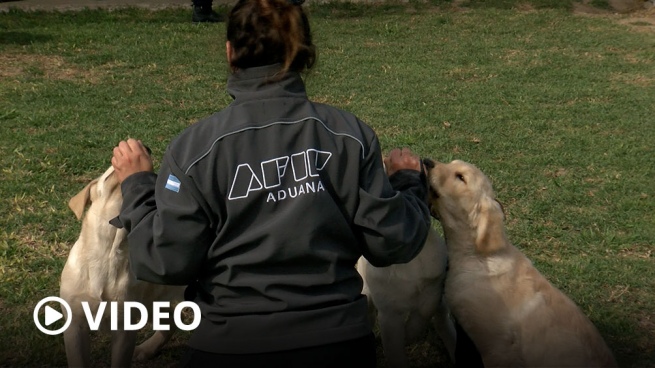The Customs received this monday 13 puppies of Labrador Retrievers, Golden Retrievers and German Shepherds, and next week they will arrive other 15used in non-invasive narcotics and currency control actions, and make up a binomial with their guides, who take them to live in their homes and consider them part of their family.
In the coming weeks, the recently incorporated dogs will remain in the Canine Training Center of the General Directorate of Customs (DGA)where they will be playfully instructed with skill and exploration exercises, to then be assigned to their guides, a pioneering methodology in Latin America, with whom they establish a “very special” bond for being companions for years or even a lifetime.
During a visit by Télam to this training center, located in the Buenos Aires town of Boulogne, Deborah Di Biaseone of the instructors, expressed the emotion of the team for receiving a new litter of puppies about 60 days old that will soon be added to customs tasks.
“Many times dogs are thought to be abused or addicted when they are not even in contact with the substances. It is far from that, it is training based on the game,” said the instructor.
What does the training period consist of?

In the case of substances, they work with a “pseudo”, that is, elements that are impregnated with the smell of the substance to be trained, so that “at no time do the dogs have contact with them.”
In the case of currency, bills are shredded and small bags are assembled, impregnated with the smell of ink that the dog will recognize later.
“They have a much more acute olfactory capacity than us and, in addition, the ability to feel all odors and discriminate some specific ones, for example that of a particular substance inside a suitcase that can be impregnated with various odors, such as perfume and antiperspirant, among others,” explained Di Biase.

During the training sessions, which take place twice a day and individually, different exercises are organized, such as searching suitcases, drawers or a vehicle for a hidden item that, if found, gets reinforcement, which can be food or toys, which is why it is sought that they be “appetizing dogs, with the ability to play”.
Once the training period is over, the dogs begin their “work stage”, accompanied by an assigned guide, who integrates them into their homes and families.

“The best thing is that they live together because the bond is reinforced and because it is important to know daily issues, such as if the dog was playing all day and if he has energy to work, if he ate, if he was sick,” said the trainer.
In total there are 43 dogs that are in the process of training and 115 who already participate in customs operations at airports, border crossings, ports, fiscal warehouses and postal centers, among others.
Customs works with the German and Belgian sheepdog, Labrador and golden retriever breeds, which are considered “those with the best conditions for this job.”

the dogs participate in these tasks for approximately eight yearsdivided into different stages according to the age of each one and, once retired from the service, they are generally adopted by their guides or their relatives, since it is difficult to separate as they are “partners throughout life”.
In dialogue with Télam, Axel Occhionehead of the Canine Training Center Division, highlighted the work of these dogs in controlling the entry and exit of drugs into the country and the outflow of foreign currency, and celebrated the incorporation of 28 puppies, within the framework of the Strengthening of the Customs Control System foreseen in the AFIP Strategic Plan 2021-2025.
He also indicated that the DGA has “a sense of responsible ownership and well-being of the animal”, from which it must take charge of the care and health care of the dogs throughout their lives.
To do this, the training center has a veterinary office, which has an inpatient room with six beds, and a complete operating room where up to two surgeries are performed per day.
In addition, the center has 68 general housing and rest kennels, six outdoor recreation and training pens, and two 1,600-square-meter sheds with a training track.

This year, the DGA had “the support of all the countries of the American continent” so that the World Customs Organization (WCO) recognized this canine center as “one of the 18 regional centers worldwide and the first in Latin America “, highlighted the deputy director general of Metropolitan Customs Operations, Rosana Lodovico.
Lodovico stressed that the dogs represent “a non-intrusive customs control method”, an initiative aligned within the WCO’s Regulatory Framework of Standards to Secure and Facilitate Trade (SAFE).
“The dogs are of vital importance, not only for the control of foreign trade, but also to prevent and combat smuggling, the fight against drug trafficking and the flight of foreign currency,” they concluded.


















